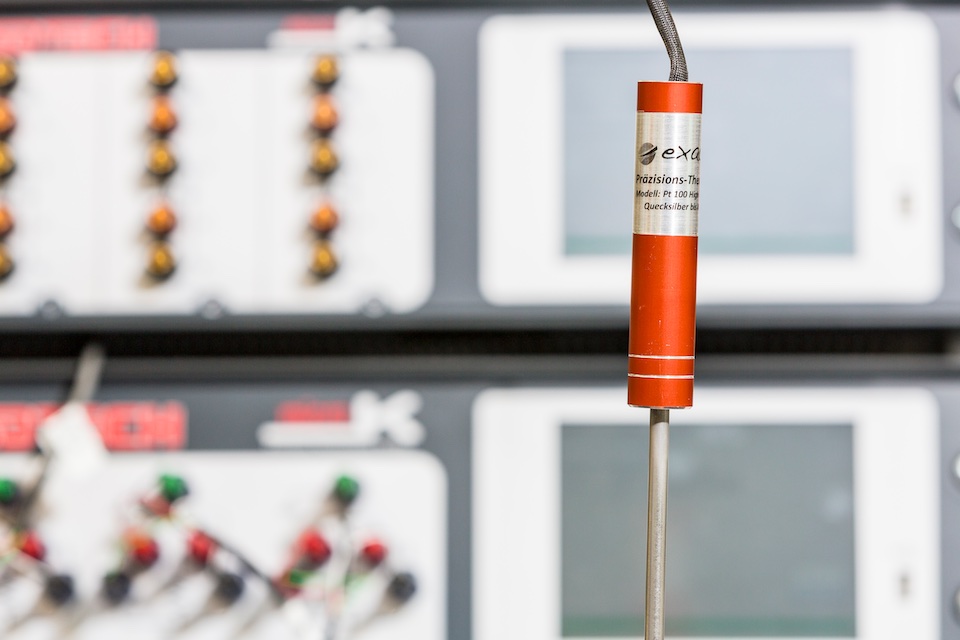Pt100 resistance thermometers are precise temperature detectors that are widely used in a variety of industrial and scientific applications. Their principle is based on the variation of the electrical resistance of a platinum wire as a function of temperature. The “Pt” in Pt100 stands for platinum, the material the wire is made of, and the “100” indicates that the resistance at 0°C is exactly 100 ohms.
Pt100 resistance thermometers offer a wide temperature range, from -200°C to +850°C, and are characterised by their high accuracy. Their resistance-temperature curve is almost linear, which facilitates calibration and interpretation of the measured values.
These sensors change their electrical resistance proportionally to the temperature change. The temperature coefficient is about 0.385 Ohm/°C at 0°C. Pt100 sensors usually have two, three or four connections. Accordingly, they can be used in various circuit configurations, including 2-wire, 3-wire and 4-wire circuits.
To ensure accurate measurements, Pt100 RTD temperature probes must be protected from external influences such as moisture and mechanical stress. This is often done by using protection tubes. In addition, they should be calibrated regularly, either in specialised laboratories or with the help of reference thermometers.
Pt100 sensors are used in numerous applications, including the food industry, laboratories, air conditioning technology, the automotive industry and chemical process engineering.
Table of Contents
How do resistance thermometers work?
RTD temperature probes are widely used for precise temperature measurements. The usual temperature range is between about -50 °C and 600 °C, although special applications exist where resistance thermometers are used from -200 °C to over 1000 °C[1]. The Pt100 resistance thermometer shown is from the calibration laboratory of the Klasmeier company.
The measuring principle of these thermometers is based on measuring the electrical resistance of temperature detectors, for which Ohm’s law[4] is fundamental:
U = R ⋅ I = constant
where:
U = voltage,
R = resistance,
I = current
In school lessons, Ohm’s law is often depicted as a triangle that illustrates the relationship between current, voltage and resistance.

If two of these values are known, the third can be calculated. In the circuit diagram, Ohm’s law is shown as in the following graphic.

The relationships of the resistance measurement and thus the resistance thermometers can also be shown graphically in a chart.
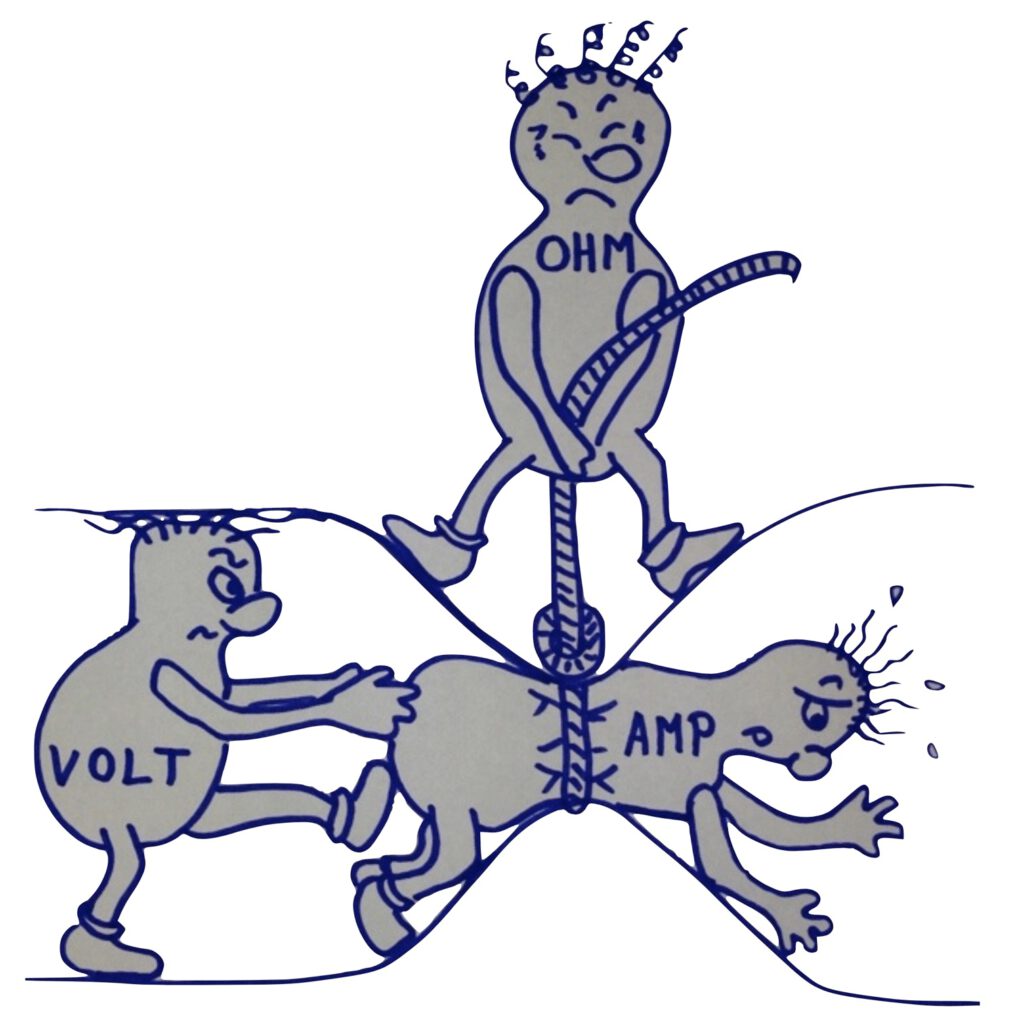
Here, the “VOLT male” (U – voltage) is pushed through a tube by the “AMP male” (I – current), while the “OHM male” (R – resistance) tries to prevent this by narrowing the tube. The success of the “OHM male” depends on the temperature: The warmer it is, the harder it is for the “VOLT male” to move the “AMP male”. Since this temperature-dependent effect is reproducible, the principle of electrical resistance measurement can be used to measure temperature. A measured resistance R in ohms is converted into a temperature T in °C or K via a known relationship.
In principle, any electrical conductor to which Ohm’s law applies can be used as a thermometer. The specific resistance is the physical constant that describes this property. An overview in shows the various specific resistances[2] of materials at 20 °C.
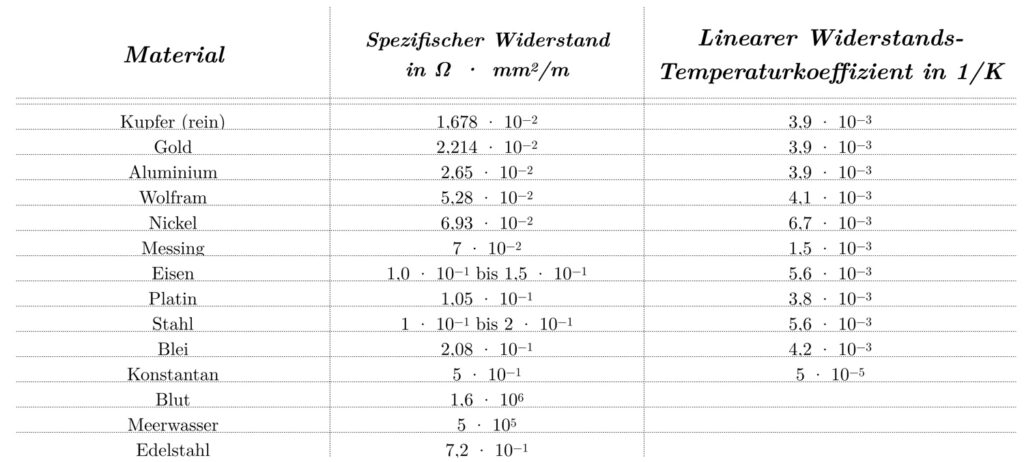
Although all the materials mentioned can basically be used for temperature measurement, there are certain selection criteria for the material selection of thermometers. The material should have a high resistivity and be fundamentally suitable. For example, human blood has an excellent resistivity of 1.6×106 Ω⋅mm2 /m, but is not suitable for the industrial production of thermometers. Metals are more suitable for this purpose.
In addition to the specific resistance, the linear resistance-temperature coefficient is also important. This describes the change in the resistance of a material per degree Celsius and is given in 1/K. It can also be referred to as sensitivity. It can also be referred to as sensitivity. To minimise the demands on the measurement technology, this coefficient should be as large as possible. It is therefore necessary to find the best compromise between costs, basic suitability of the material, specific resistance and resistance-temperature coefficient.
Nickel and platinum have proven to be suitable materials. Initially, nickel temperature detectors, such as Ni100, were considered favourites because they showed higher sensitivity than platinum temperature detectors. However, they showed higher limiting deviations and a limited temperature range. The standard for nickel thermometers, DIN 43760 [3], was withdrawn in the 1990s. Since then, nickel temperature detectors have mainly been used in special technical applications.
Over time, platinum temperature detectors, such as Pt100, have become established. They are widely used in industrial measurement technology and today represent the standard for electrical temperature measurement with resistance thermometers.
The Pt100 characteristic curve for resistance thermometers simply explained
Platinum sensors have established as resistance thermometers. The relationship between the temperature and the resistance in platinum thermometers is not described proportionally, but with a higher order polynomial:

Hereby mean:
R(T) = resistance of the thermometer
R0 = resistance of the thermometer at 0 °C
A, B, C, … = Individual parameters of the thermometer or standard
T = temperature
Callendar-Van Dusen Equation
The Callendar-Van Dusen equation is a formula used to describe this relationship between the temperature and electrical resistance of a platinum resistance temperature sensor.
The Callendar-Van-Dusen equation is also known as “CVD” and has been used since the 1920s. The characteristic curve is standardised in DIN EN 60751, which describes industrial platinum resistance thermometers and platinum temperature sensors. It was first published in the 1990s and is still valid in its latest revision as DIN EN 60751:2009-05.
The Callendar-Van-Dusen equation itself can be given in two parts, for temperatures above and below 0 °C:
For temperatures T > 0 °C:

For temperatures T < 0 °C:

Hereby is:
- R(T) the resistance at temperature ( T )
- R0 is the resistance at 0 °C
- A, B, and C are coefficients dependent on the platinum resistance thermometer
The coefficients for the Callendar-Van-Dusen equation are standardised in DIN EN 60751:2009-05:
A=3,9083×10 −3 °C-1
B=−5,775×10 −7 °C-2
C=−4,183×10 −12 °C-4
However, it is also possible to calibrate separate thermometers and calculate individual coefficients. This has the advantage that the thermometer no longer has to be evaluated on the basis of the limit deviations of the standard, but can be individually adapted to its own characteristic curve.
The Callendar-Van Dusen equation makes it possible to make very precise temperature measurements by substituting the measured resistance of the thermometer into the Callendar-Van Dusen equation and calculating the temperature.t.
The following graph shows the two temperature ranges of the Callendar-Van-Dusen equation. The temperature range from -200 °C to 0 °C is shown in blue and the temperature range from 0 °C to 850 °C is shown in red.

The Nominal Resistance R0 of resistance thermometers
In order to better classify the temperature detectors, the so-called nominal resistance R0 was introduced in the standard DIN EN 60751. This describes the electrical resistance of the temperature detector at 0 °C. For example, a Pt100 temperature detector at 0 °C has a resistance of 100 ohms. The following nominal resistances are listed in the standard:
- Pt 10 = 10 Ohm @ 0 °C
- Pt 100 = 100 Ohm @ 0 °C
- Pt 500 = 500 Ohm @ 0 °C
- Pt 1.000 = 1.000 Ohm @ 0 °C
Alternative nominal resistances such as Pt 25, Pt 2.5 or Pt 0.25 are used for precision thermometers and often meet the requirements of the ITS-90. These are then known as SPRT or standard thermometers. For laboratory applications, Pt 25 thermometers are often preferred because they offer a good compromise between stability, sensitivity and self-heating.
Temperature coefficient of resistance thermometers
The difference between standardised thermometers and standard thermometers according to the ITS-90 can be seen in the so-called temperature coefficient, which is defined in the standard by a resistance measurement at 0 °C and 100 °C:
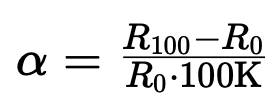
Hereby mean:
alpha = Increase of the thermometer in 1/K
R100 = resistance at 100 °C in Ohm
R0 = resistance at 0 °C in Ohm
The alpha value of industrial temperature detectors according to the standard is 3.85 10^-3/K, while the alpha value of standard thermometers according to ITS-90 is 3.92875 10^-3/K. This value corresponds to the sensitivity of spectrally pure platinum in this temperature range.
Sensitivity of resistance thermometers
The sensitivity of a resistance thermometer describes how much the resistance of the sensor changes in relation to a change in temperature. It is a measure of how precisely the sensor reacts to temperature changes. With the Pt100, the resistance changes by approximately 0.385 ohms for every degree Celsius change in temperature. This rate of change, known as the temperature coefficient, is a direct indication of the sensitivity of the sensor. Sensitivity is critical to the accuracy and resolution of the sensor. A sensor with higher sensitivity can detect smaller temperature changes and provide more accurate temperature measurements. This is particularly important in applications where precise temperature control is required, such as in laboratories or in industrial process control.
However, it should also be noted that temperature sensors with a high sensitivity often have a high level of self-heating and are less stable over the long term. For this reason, the ratio between the nominal resistance and sensitivity of a temperature sensor must be selected very carefully.
In order to achieve a defined nominal resistance, the length or diameter of the platinum wire in the measuring resistor is adjusted. This not only changes the resistance, but also the sensitivity of the sensors to approx:
- Pt 10 = 0,04 Ohm / K
- Pt 100 = 0,4 Ohm / K
- Pt 500 = 2 Ohm / K
- Pt 1.000 = 4 Ohm / K
Connection technologies of resistance thermometers
Resistance thermometers can be connected to measuring devices, data loggers or bridges, and there are various techniques for this.
- Two-wire technology
- Three-wire technology
- Four-wire technology
Two-wire technology
The two-wire technique shows how to connect a temperature sensor to a measuring device, as shown in the picture. It is important to consider the resistance of the connecting cables because it is connected in series with the temperature detector.

The resulting measurement is the sum of the resistance of wire 1, the actual temperature sensor and wire 2, which leads to an increased measurement. Therefore, a correction of the measurement result is absolutely necessary in order to eliminate measurement errors.
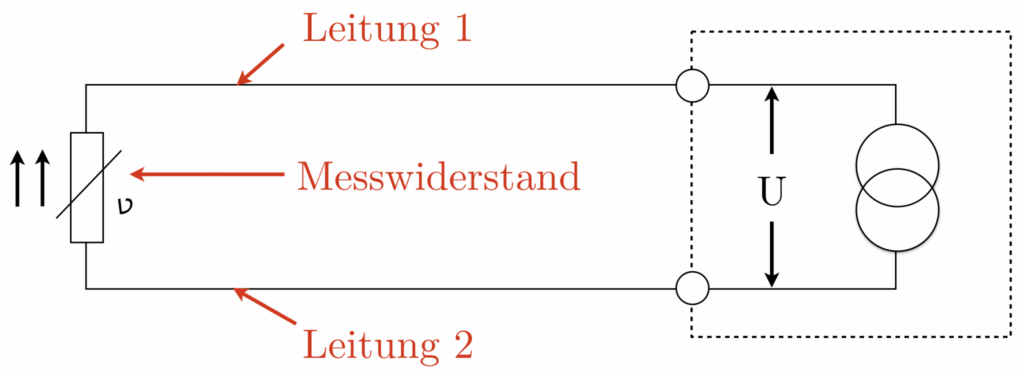
An example calculation demonstrates the amount of measurement error under certain application conditions. Assume a temperature sensor is connected by a copper wire, under the following specified conditions:
- pecific resistance of the copper wire at room temperature: 0.017
- Cross-section of the wire: 0.5 mm^2
- Length of the wire: approx. 50 m
The measurement error due to the connecting cable can be calculated using the equation
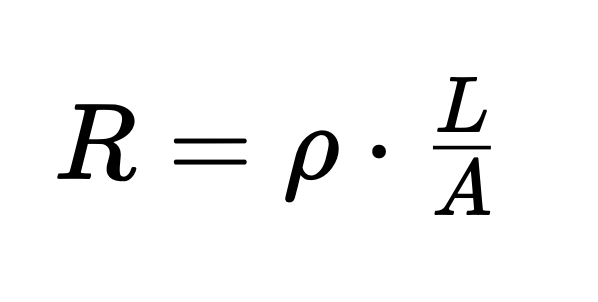
can be determined, whereby:
- is the wire resistance,
- \rho the specific resistance,
- L the wire length and
- A the area of the cross-section.
In this context, a wire resistance of 3.4 ohms results:

Taking into account a sensitivity ( E ) of a PT 100 temperature sensor of approx. 0.385 Ohm / K, a measuring error of 8.8 K results.

The cable length of approx. 50 m must be taken into account twice for the ” way to” (cable 1) as well as for the ” way back” (cable 2).
Historically, it was quite conventional to connect thermometers in production facilities using the two-wire technique. Before the era of digital technology, which simplifies the correction of systematic errors, correction tables were used to achieve accurate readings.
An example illustrates correction values of a10 m long connection wire as a function of the wire cross-section.

For a connecting wire with a wire cross-section of 0.5 mm^2 , the resistance in a 10 m long two-wire connection is 0.6 Ohm. This means that the measured values must be corrected by this factor. With a Pt100, this corresponds to about 1.6 °C.
The following graph shows the correction values for a Pt100 in relation to the cross-section of a 10 m long copper cable in the two-wire technique.

Three-wire technology
The three-wire technique optimises the two-wire technique, especially with a view to minimising measurement errors due to wire resistance. In this configuration, three wires are used, with two wires connected in parallel to the temperature detector and a third wire to compensate for the wire resistance.
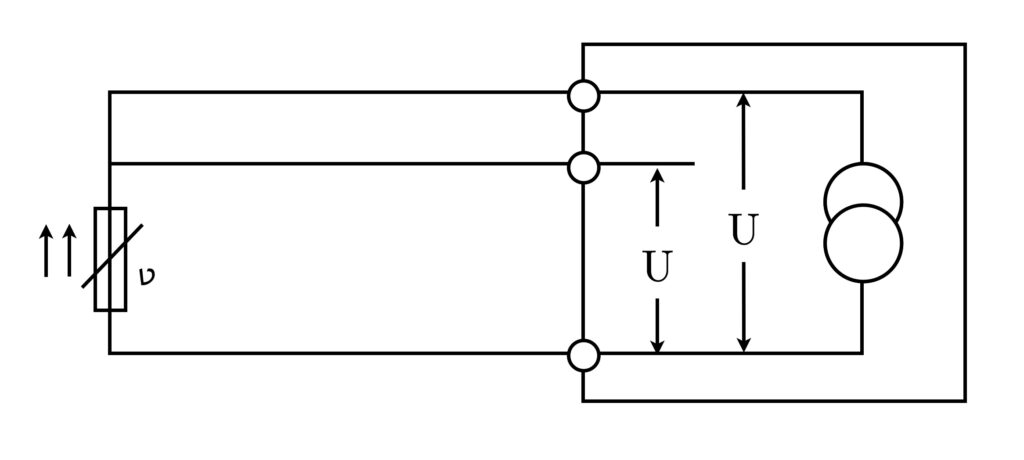
The wire resistance is compensated by the bridge, which takes into account the resistance of the third wire and therefore subtracts the total resistance of the connecting wires. This results in a more precise measurement of the actual measuring resistance, as the influences of the connecting wires are minimised.
Although the three-wire technique is a significant improvement over the two-wire technique, it is still susceptible to errors due to temperature changes and different wire lengths, which can affect the compensation of the wire resistance.
Four-wire technology
The four-wire technique, also known as Kelvin four-wire measurement, represents a further optimisation in the precision of resistance measurement, especially for applications where the highest accuracy is required. This technique uses two additional leads to supply the measurement current and measure the voltage drop across the sensor, eliminating the influence of wire resistance.
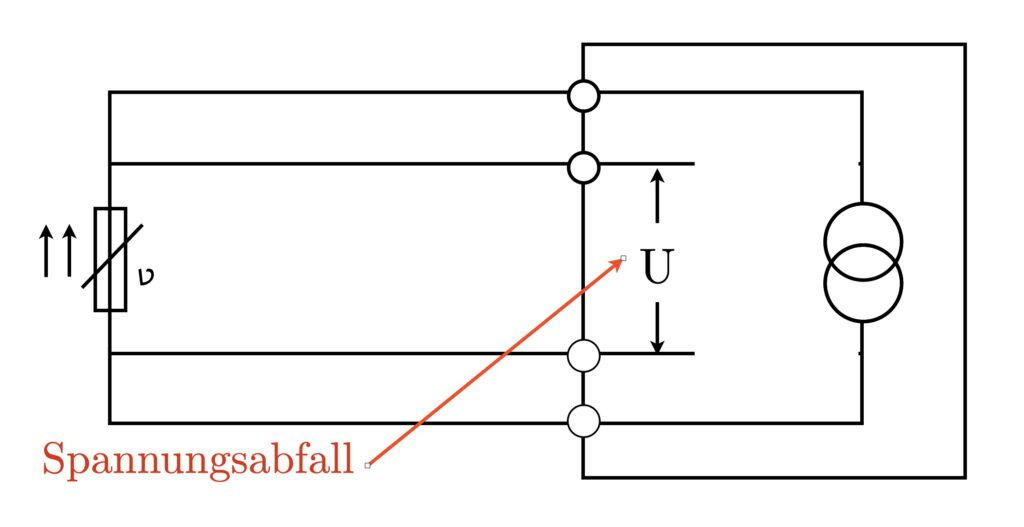
In this configuration, the measuring current flows through two of the wires (current wires), while the other two wires (voltage wires) are used to measure the voltage drop directly across the sensor. Since the measuring current does not flow through the voltage lines, the line resistance of these lines is not included in the measurement, resulting in higher measuring accuracy.
The four-wire technique is particularly useful for applications with low resistance values and long wire lengths, as it enables precise measurement that is free from the influences of wire resistance.
In summary, the three- and four-wire techniques offer improved accuracy and reliability compared to the two-wire technique by minimising or eliminating the influence of wire resistance. The choice of the most suitable technique depends on the specific requirements of the application, such as measurement accuracy, environmental conditions and economic considerations.
Source:
- Frank Bernhard: Handbuch der Technischen Temperaturmessung, 2. Auflage
- Thomas Klasmeier: Tabellenbuch „Temperatur“, Ausgabe 3
- ISOTECH Kupferpunkt-Thermometer Nr. 108462 bis fast 1100°C.
- Spezifischer Widerstand
- DIN 43760
- Ohmsche Gesetz

